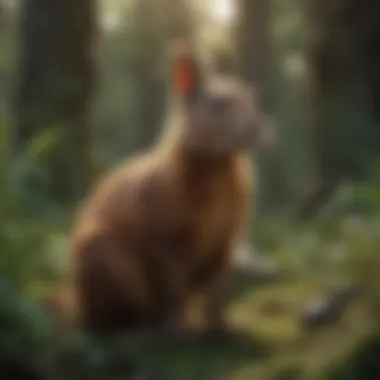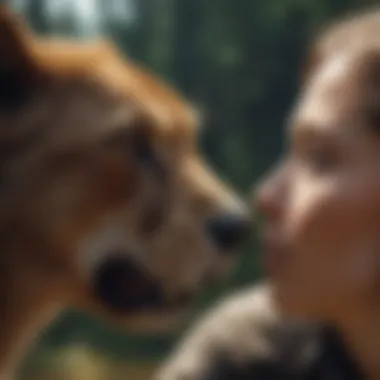The Interrelationship of Humans and Animals: Insights


Intro
The interplay between humans and animals encompasses varied dimensions, influencing our existence and environment. A detailed investigation reveals the ecological, psychological, and sociocultural threads that bind us together. Understanding these dynamics is essential for advancements in biology, psychology, and environmental science.
Research Overview
In this section, the article outlines pivotal insights gained from examining human-animal interactions. The significance of these relationships extends beyond mere companionship, suggesting profound implications for both species.
Summary of Key Findings
Research indicates that our connections with animals can significantly affect mental health and social behavior. Findings show that pets often serve as sources of emotional support, which can lead to reduced stress and anxiety levels. Additionally, conservation efforts are impacted by how human societies perceive different animal species. Understanding these perspectives can alter engagement strategies.
Research Objectives and Hypotheses
The primary aim is to dissect the frameworks that govern human-animal relationships. The study seeks to:
- Explore behavioral impacts on humans due to animal interactions.
- Analyze environmental changes stemming from these relationships.
- Evaluate psychological benefits derived from animal companionship.
The hypothesis posits that increased interaction with animals correlates with heightened well-being in humans.
Methodology
To achieve the research objectives, a structured methodology is employed. This entails a rigorous approach to studying the interrelationship of species.
Study Design and Approach
A mixed-method approach is utilized, integrating quantitative and qualitative research techniques. Surveys, case studies, and observational methods are key components. These tools facilitate a multidimensional understanding of human-animal interactions.
Data Collection Techniques
Data collection occurs through:
- Surveys: Targeting a broad demographic to assess attitudes toward animals.
- Interviews: Offering in-depth perspectives from pet owners and animal conservationists.
- Field Observations: Documenting animal behavior in relation to human activities in various settings.
These methodologies collectively provide a comprehensive view of the complex dynamics at play.
"The nature of human-animal interactions has significant implications for both ecological health and individual well-being."
In this exploration, we aim to elucidate how these connections shape our lives and the environment for both species.
Prolusion
The interrelationship between humans and animals is a topic of profound importance. Understanding this connection can reveal essential insights into both ecological systems and social structures. Animals are not merely resources or companions; they play significant roles in human health, culture, and the environment. This article will examine various elements that underscore the relevance of these relationships, focusing on how they influence behaviors, perceptions, and decision-making on both micro and macro levels.
Background of Human-Animal Interactions
Human-animal interactions have existed for millennia. Early human societies relied on animals for sustenance, labor, and companionship. Archaeological evidence suggests that domestication processes began around 15,000 years ago, leading to fundamental shifts in human lifestyles. This long history shows that animals have not only contributed to human survival, but they have also shaped social norms and cultural practices. Cultural representations of animals in art, folklore, and religion illustrate the deep-rooted connections we have forged over time.
Furthermore, in modern society, the recognition of animal sentience has ushered in a new era of understanding. Scientific studies have demonstrated that many animal species exhibit complex emotions and social structures. Such findings challenge traditional views and demand a re-examination of how humans perceive their animal counterparts in daily life, agriculture, and conservation efforts.
Purpose and Scope of the Article
The aim of this article is to provide a thorough analysis of the multifaceted relationships between humans and animals. It will explore themes such as psychological impacts, cultural representations, ecological implications, and ethical considerations. Each section intends to encapsulate both benefits and challenges, seeking to present a balanced view of these interactions. An in-depth discussion will also focus on future implications, especially considering pressing issues such as climate change and technological advancements.


In a rapidly changing world, recognizing the interconnectedness of life can foster more harmonious coexistence. Therefore, this article is directed towards students, researchers, educators, and professionals who wish to gain a deeper understanding of the subject. With insights drawn from interdisciplinary studies, it serves as a comprehensive guide to facilitate informed discussions and promote scientific literacy regarding humans' role within the animal kingdom.
Historical Context
Understanding the historical context of human-animal relationships is essential for grasping the nuances of their current interconnections. This context lays the groundwork for a comprehensive exploration of how these interactions have evolved and influenced both species. Studying the historical elements allows us to discern the benefits and challenges that have arisen from these bonds throughout time. It offers insights into the shared journey of humans and animals, revealing how cultural, economic, and environmental factors shaped these relationships.
Evolution of Human-Animal Bonds
The evolution of human-animal bonds is a multi-faceted narrative that weaves together biology, sociology, and anthropology. Evidence suggests that these bonds date back thousands of years, with domestication processes identified as key turning points. Early humans relied on animals for survival. They provided not only sustenance, like meat and milk, but also companionship and protection. Over time, selected breeds of dogs and livestock became integral to human life. Each step in this evolution signifies adaptation and mutual benefit.
In contemporary society, these bonds manifest in various forms, whether through pets, service animals, or agricultural practices. Recent studies highlight that interactions with animals can enhance human wellbeing, showing that emotional connections have deep roots in our evolutionary history. The rise of animal companionship in modern households signals a shift from utility to genuine relationships, emphasizing an emotional aspect. More research is needed to fully understand how these relationships affect human behavior and wellbeing today.
Cultural Representations of Animals
Cultural representations of animals reveal much about the human experience and society's values. Throughout history, different societies have depicted animals in art, folklore, and literature. These representations often reflect the way humans perceive their role in relation to animals.
For example, in ancient myths, animals served as symbols of power, loyalty, or even deities. In modern times, literature and films continue to highlight animal traits, portraying them as heroic, loyal, or wise. The portrayal of animals can influence public perception and policy regarding animal welfare and rights.
- Here are some examples of how cultures represent animals:
- Spiritual Symbols: Many cultures view certain animals as spiritual entities.
- Mythological Figures: Creatures like dragons or griffins appear in numerous myths.
- Metaphors in Literature: Animals are often used to signify human traits or experiences.
The varied representation of animals across cultures emphasizes the complexity of human-animal relationships, showcasing both affection and exploitation. Understanding these representations can aid in addressing contemporary issues like animal rights and conservation.
"Animals hold a mirror to our humanity, prompting reflection on our values and responsibilities."
In summary, examining the historical context of human-animal relationships not only deepens our understanding of these dynamics but also lays the groundwork for future discussions. Awareness of the evolution and cultural aspects enriches this discourse and highlights the importance of ethical considerations today.
Ecological Perspectives
Understanding the ecological perspectives of human-animal interrelationships is crucial in comprehending the intricate tapestry of ecosystems. This section underscores the interdependence of species and highlights the consequences of human actions on these delicate balances. By recognizing these relationships, we can better appreciate both the benefits and challenges posed by our interactions with animals and their habitats.
Human Impact on Animal Habitats
Human activities have significantly altered animal habitats worldwide. Urbanization, agriculture, and industrialization have led to habitat destruction, fragmentation, and degradation. For example, deforestation to make way for farmland results in the loss of biodiversity. Many species face extinction as their living spaces shrink or disappear altogether. This has a cascading effect on ecosystems, disrupting food chains and nutrient cycling.
Furthermore, pollution plays a detrimental role in animal habitats. Rivers, oceans, and air are often contaminated, affecting not only the immediate environments but every species relying on those systems. Marine life suffers from plastic pollution, while terrestrial animals are affected by pesticides and chemicals. It is evident that understanding our impact on these habitats is a cornerstone of fostering more harmonious relationships.
"Human beings, in their efforts to advance civilization, often forget the intricate balance that must be maintained with the natural world."
Conservation Efforts
In response to the adverse effects of human activities, numerous conservation efforts have emerged. These initiatives range from habitat restoration to legal protections for endangered species. Organizations dedicated to wildlife preservation work to create reserves and protected areas, ensuring that animals can thrive in their natural environments. A prominent example is the conservation work undertaken by the World Wildlife Fund, which focuses on protecting endangered species and their habitats.
Public awareness campaigns also play a significant role. Educating communities about the importance of biodiversity fosters a sense of stewardship towards local environments. Involving local populations in conservation initiatives can lead to innovative solutions and increased commitment to preserving ecosystems.
Key strategies in conservation include:
- Establishing protected areas and wildlife reserves.
- Restoration of degraded ecosystems.
- Legal frameworks that ensure the protection of specific species.
- Community engagement in conservation practices.
Through these efforts, it becomes clear that conservation is not merely about preserving animals, but also about maintaining the ecological balance vital for human life. This realization reinforces the need for sustainable practices and policies that reflect an understanding of our interconnectedness with the natural world.
Psychological Aspects


Psychological aspects of the human-animal relationship are significant for understanding well-being and emotional health. The bond between humans and animals touches on emotional connections, therapeutic benefits, and overall impacts on mental health. Highlighting these elements is essential for grasping how interactions shape individual lives and societies. With more people recognizing the value of animal companionship, it is pertinent to delve into their multifaceted effects on psychological health.
Emotional Bonds Between Humans and Animals
Emotional bonds between humans and animals create profound connections that can enhance quality of life. Many people form attachments with pets, viewing them as family members. Research indicates that these bonds can trigger positive emotional responses. For instance, oxytocin, a hormone linked with bonding, is released during interactions. This biochemical reaction fosters feelings of happiness and decreases stress levels.
- Connection and companionship: Animals offer unconditional love and companionship. Their presence can reduce feelings of loneliness and improve social interactions.
- Emotional expressions: Animals often reflect emotions, providing a mirror for human feelings. These interactions can deepen emotional understanding.
Psychological studies underscore that owning a pet often leads to increased feelings of joy, security, and fulfillment. The emotional bond established can be therapeutic.
Therapeutic Benefits of Animal Companionship
Animal companionship has been recognized for its therapeutic qualities in various fields, including psychology and physical therapy. This phenomenon is especially true in regards to service animals and therapy animals that assist individuals with disabilities or mental health issues.
- Support for mental health: The presence of animals can significantly alleviate symptoms of anxiety, depression, and PTSD. Just petting an animal can stabilize heart rates and reduce stress levels.
- Structure and routine: Caring for an animal requires routine, which can help bring stability to a person's life. This structure can be beneficial in managing mental health conditions.
The therapeutic benefits of such companionship are evident in multiple studies. As animals provide observational comfort and social support, they present avenues of healing that are both immediate and profound.
Impact on Human Mental Health
The influence of animals on human mental health is substantial. Evidence shows that interacting with animals can lead to improved psychological well-being. Many mental health professionals now consider animal-assisted therapy as a powerful adjunct to traditional psychotherapy.
- Reduction in stress and loneliness: Regular interaction with pets reduces cortisol levels, a hormone associated with stress. Lower stress contributes to overall mental well-being.
- Increase in socialization: Animals can serve as social facilitators, allowing people to connect with others. This socialization can enhance feelings of belonging.
Furthermore, studies have established a correlation between pet ownership and increased happiness. As such, the relationship between humans and animals is not just beneficial but is essential for mental health maintenance. These psychological aspects unveil the significant role animals play in human lives, navigting complexities of mental well-being in everyday interactions.
"The bond with an animal can be one of the greatest sources of joy in one’s life."
The evolving understanding of these dynamics can inspire further research and explore innovative therapies that incorporate animal interactions for improved psychological health.
Sociocultural Influences
Understanding the sociocultural influences in the context of human-animal interrelations is critical. This subject encompasses how animals fit into human societies, the perceptions surrounding them, and how these views shape social structures, traditions, and economies. Recognizing the socio-cultural dynamics allows for a deeper appreciation of the multifaceted bonds we share with animals. These influences contribute to shaping collective identities, promoting conservation efforts, and fostering ethical considerations regarding animal treatment.
Role of Animals in Societies
Animals have been integral to human societies throughout history. They play various roles that extend beyond mere companionship. For instance:
- Cultural Symbols: Many societies use animals as symbols in art, mythology, and religion. They represent virtues, power, or the natural world. Common examples include the lion symbolizing strength and the dove representing peace.
- Working Animals: In agricultural contexts, animals such as horses, oxen, and dogs have served labor purposes. These working animals have not only facilitated agricultural production but also helped shape human settlements and economies.
- Social Cohesion: The presence and importance of animals can enhance community bonds. Events such as livestock shows and pet fairs bring people together, fostering community spirit and shared interests.
Animals also influence daily social interactions. Pet ownership is linked to increased social connections and emotional well-being. People with pets often report having a broader social network.
Economic Contributions of Animal Industries
The economic implications of animals in society cannot be overstated. Various industries rely heavily on animals and have significant impacts on local and global economies. Consider the following key areas:
- Agriculture: Livestock farming provides food, clothing, and various by-products. The poultry, dairy, and cattle industries contribute significantly to the economy. In many regions, these sectors are vital for employment and sustenance.
- Ecotourism: Wildlife tourism has become increasingly popular, with many economies benefiting from the activity. This form of tourism fosters conservation awareness and supports local communities. The presence of species like elephants and big cats can attract thousands of visitors annually.
- Research and Development: Animals are crucial in medical and scientific research. They are often used in laboratory settings to develop treatments and medications, leading to substantial advancements in human healthcare.
In summary, the role of animals within societies is profound and layered. From cultural and social ties to economic contributions, these relationships reveal how deeply intertwined human lives are with the animal kingdom. The ongoing exploration of this topic is necessary for building a sustainable and ethical future for both humans and animals.
Ethical Considerations
Ethical considerations in the interrelationship between humans and animals are crucial to understanding the broader implications of these connections. As societies evolve, the ethical treatment of animals has become increasingly important. This section examines the fundamental aspects of ethical considerations, emphasizing the necessity to align animal welfare with human progress. The aim is to analyze both the rights of animals and the morality surrounding their use in various contexts, including research and companionship.


Animal Rights Movements
The animal rights movement represents a significant push towards recognizing animal sentience and their inherent rights. Activists argue that animals deserve not only to be treated humanely but also to live free from exploitation and harm. This movement has led to a wider acknowledgment of the legal status of animals. Moreover, various campaigns have raised public awareness about issues such as factory farming, animal testing, and habitat destruction.
In recent years, prominent organizations like PETA and the World Animal Protection have undertaken efforts to educate the public and persuade lawmakers to enact strict regulations against animal cruelty. The influence of these movements extends to consumers who have become more conscious about their purchasing choices. Many people now prefer products that are cruelty-free or sourced from humane practices. The rise of plant-based diets also ties into these movements, reflecting a growing preference for ethical consumption.
Ethics of Animal Research
The ethics of animal research presents significant dilemmas within the scientific community. Researchers often rely on animal models to study diseases, develop treatments, and understand biological processes. However, this raises urgent concerns regarding animal welfare and the justification of such practices. The principle of the Three Rs—Replacement, Reduction, and Refinement—serves as a guiding philosophy in the ethical use of animals in research.
- Replacement: Encouraging the use of alternative methods to avoid animal testing.
- Reduction: Minimizing the number of animals used in experiments to the least necessary.
- Refinement: Enhancing procedures to reduce pain and distress for the animals involved.
By adhering to these principles, researchers aim to advance scientific knowledge while upholding ethical standards. Furthermore, the development of technology, such as software modeling and in vitro testing, can facilitate animal-free research. This shift reflects a broader ethical commitment within the scientific community to find a balance between advancements in human health and the humane treatment of animals.
"The tension between animal welfare and scientific progress compels ongoing discussions about the ethical implications of research practices."
This narrative on ethical considerations emphasizes the need for a thoughtful approach to the multifaceted relationship between humans and animals. It advocates for continuous improvement in how society views and interacts with non-human beings.
Future Implications
The concept of future implications regarding the relationship between humans and animals is critical in an era defined by rapid change. These implications extend to environmental consequences, technological advancements, and broader sociocultural shifts. Understanding them helps to shape policies, conservation strategies, and educational efforts aimed at fostering a sustainable coexistence. As we navigate complex global challenges, such as climate change and biodiversity loss, recognizing the interdependent nature of our existence is paramount.
Climate Change and Its Effects on Animal Populations
Climate change presents a formidable challenge to animal populations worldwide. The impact is multifaceted, affecting habitats, food availability, and migration patterns.
- Shifts in Habitat: Animals are adapting to changing climates, migrating towards cooler areas. This could disrupt ecosystems and lead to conflicts with humans.
- Altered Breeding Patterns: Temperature changes can affect timing of breeding, potentially leading to mismatches in food supply for young.
- Increased Extinction Rates: Vulnerable species are at a higher risk due to habitat loss and changing environmental conditions. According to research, many species may face extinction if current trends continue.
The ramifications of these shifts are profound, affecting not just animal survival but also human economies that rely on biodiversity. As species adapt, ecosystems are likely to become unbalanced. It is necessary to pursue conservation efforts that address these changes.
The Role of Technology in Human-Animal Interactions
Technology increasingly mediates the relationship between humans and animals, offering opportunities and posing unique challenges.
- Tracking and Monitoring: Tools like GPS collars and drones help in wildlife monitoring, allowing researchers to gather real-time data on animal movement and health.
- Improved Welfare Practices: Technological advancements in veterinary care optimize treatment and enhance the overall welfare of domesticated animals.
- Educational Tools: Interactive educational platforms leverage virtual reality and augmented reality to educate the public about different species and their habitats.
However, reliance on technology also brings concerns. Over-dependence could lead to a disconnect from nature, diminishing our intrinsic understanding of animal behaviors and needs. Balancing technology's benefits with a conscious effort to engage with the natural world remains crucial.
"The future of our planet is intertwined with the fate of its animal inhabitants; both must be nurtured for a viable world."
These future implications highlight a shifting landscape where awareness and action can significantly influence the dynamics of the human-animal relationship. This understanding can guide effective strategies for conservation and responsible technological integration.
Culmination
The examination of the interrelationship between humans and animals provides significant insights that are crucial for multiple fields of study and practice. This article has shown that the bonds shared between humans and animals influence ecological systems, cultural practices, and psychological health. Understanding these connections is paramount for educators, researchers, and professionals who aim to foster a dense relationship with the natural world.
Summary of Key Points
The article thoroughly explored numerous aspects of human-animal interactions:
- Historical context revealed the evolution of bonds through cultural representations, highlighting how deeply rooted these connections are in societal frameworks.
- Ecological perspectives illustrated the human impact on animal habitats and careful conservation efforts necessary for maintaining biodiversity.
- Psychological aspects detailed the emotional bonds and the therapeutic benefits associated with animal companionship, which can significantly affect human mental health.
- Sociocultural influences demonstrated the role of animals within societies and the economic contributions these industries bring.
- Ethical considerations surfaced around animal rights movements and the ethics involved in animal research, prompting valuable discussions.
- Future implications highlighted the pressing challenges posed by climate change and the emerging role of technology in shaping human-animal relationships.
The interplay between humans and animals is not solely a matter of coexistence but also a reflection of ethical, cultural, and ecological responsibility.
Call for Further Research
Continued research is vital for several reasons:
- Addressing gaps in knowledge: Many areas of human-animal interaction remain underexplored. For instance, the long-term effects of urbanization on wildlife behavior needs more investigation to inform better conservation practices.
- Evolving dynamics of relationship: As society progresses, so too does the relationship humans maintain with animals. Understanding these shifts will help in mitigating potential conflicts and enhancing coexistence strategies.
- Technological advancements: Emerging technologies present new avenues for studying animal behavior and improving human-animal relationships. Areas such as wearable technology for pets and AI-driven animal monitoring systems show promise in this regard.
- Public policy impact: Research can influence legislation and public policy aimed at animal welfare and conservation, which are critical in an era of environmental crisis.















